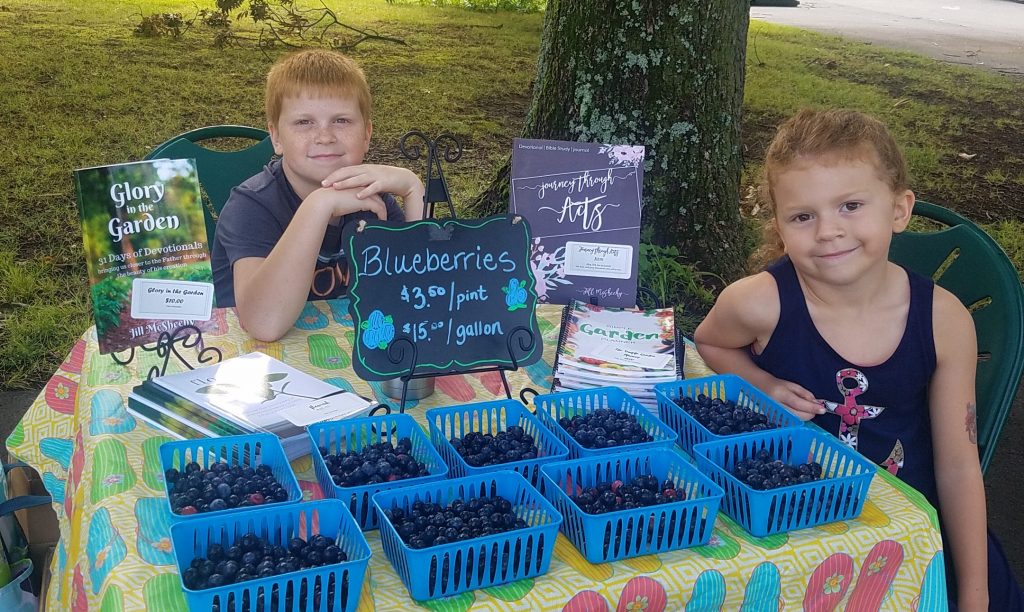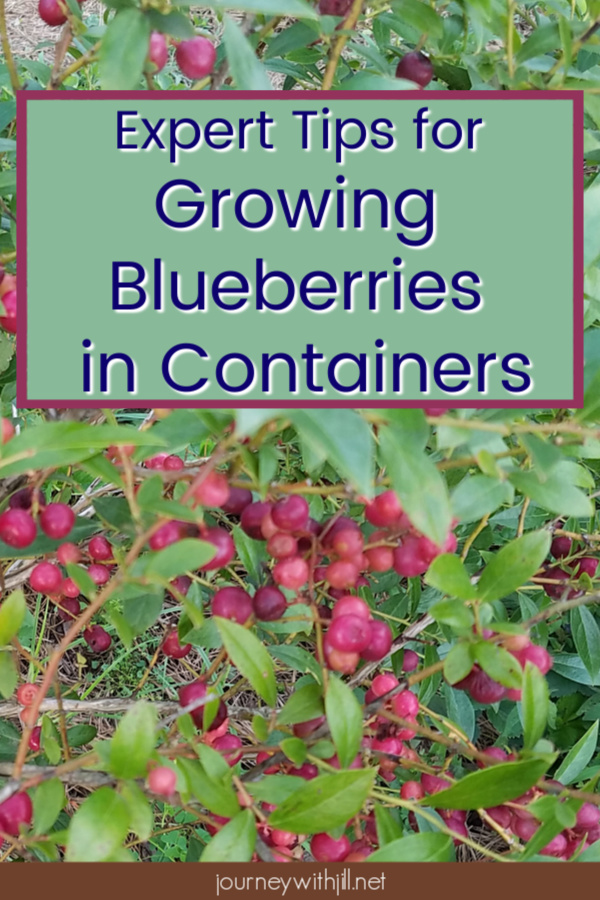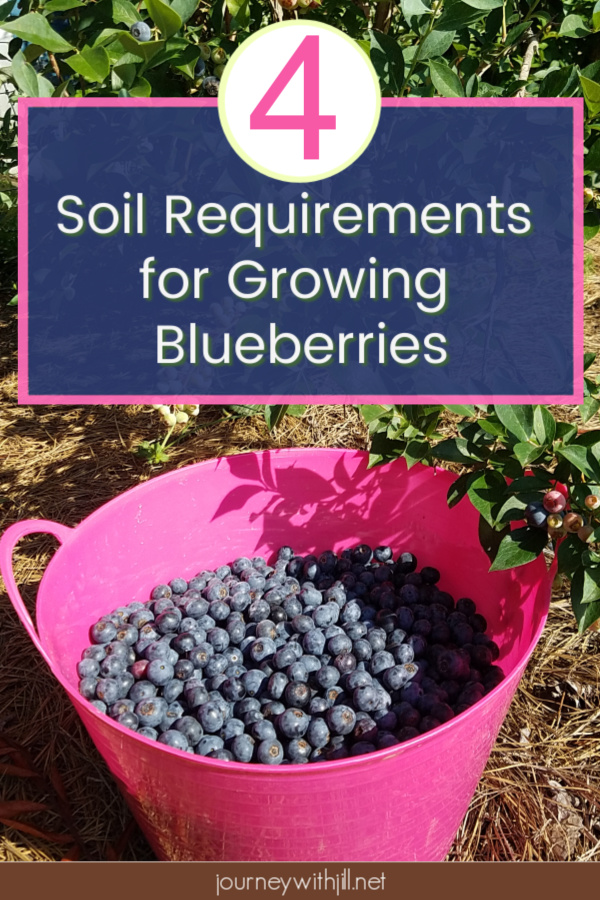How to Grow Blueberries in Containers or in the Ground – tips from Lee Reich
The most common edible plant question I get asked is how to grow blueberries. What’s not to love? Delicious off the bush, they cost a lot at the grocery store, and when you grow your own, you avoid needless pesticides.
I planted four blueberry bushes my first garden season, and just two seasons later we harvested more than we could eat. A couple of years after that, we began selling our excess at a local farmer’s market.

Growing Blueberries when Soil Isn’t Perfect
But, I know not everyone experiences the beginner’s luck that I did. That may be why my list of 4 Mistakes Beginning Gardeners Make when Growing Blueberries is one of my most-read articles.

The truth is, you can grow blueberries pretty easily, as long as they live in the right soil conditions. My soil pretty much came packaged in a pretty, 4.8 pH bow, but I have had lots of people ask me about what to do when their soil isn’t perfect for blueberry growing.
I’ve also had readers ask me questions about growing blueberries in containers, which I don’t have any experience with either.
That’s why I decided to ask horticulturist Lee Reich to chat with me on the Beginner’s Garden Podcast all about growing blueberries.
Lee gives great information on growing blueberries that every beginner and seasoned gardener alike can put to use in their own gardens. Click below to listen or scroll down to read Lee’s tips on growing blueberries:
4 Soil Requirements Blueberries Must Have to Grow:
Acidic Soil
The most important requirement of blueberries is an acidic soil. This is non-negotiable. Lee recommends a pH of between 4.0 and 5.5, with 5.5 being the absolute maximum.
My first season I tested my soil. The 4.8 pH revealed I needed to amend my general garden quickly, but this proved perfect for growing blueberries. I believe this is why I have had success from the very beginning. The soil pH matters, and it matters so much that it’s worth your time and money to do a soil test.
Organic Matter
Blueberry bushes love a soil rich in organic matter. I amended my soil before planting with compost and pine needles. Peat moss is also often recommended. Apply a layer of mulch each season not only to keep the soil moist and weed-free but also to continually nourish the soil with the organic matter the bushes love.
Not Too Fertile
Although blueberry bushes enjoy organic matter, they don’t necessarily thrive in highly fertile soil. So skip the fertilizers (especially synthetic ones).
I did not apply any fertilizer to my bushes until they were a few years old. Then I began supplementing them with an organic form of nitrogen, such as organic cottonseed meal or soybean meal.
Moist and Well-Drained
Blueberries need ample water, especially the first year as they establish themselves. The root systems are extremely shallow, taking up the top few inches of topsoil. This leaves them vulnerable to drying out, so ensure they stay watered. I recommend a heavy layer of mulch to limit evaporation and to discourage weed growth, which will compete with the bushes for water.
But, don’t go overboard with the irrigation. Blueberry bushes do not like “wet feet.” Avoid planting bushes in a low-lying area of your property, especially if your soil contains a high percentage of clay content, which will retain moisture.

How to Grow Blueberries without Acidic Soil
What do you do if you test your soil and discover its pH falls above 5.5?
It’s time to get serious about amending that soil. Lee recommends adding pelletized sulfur at the following rates for every 100 square feet to lower the pH by 1 point:
- 3/4 pound for sandy soil
- 1.2 pounds for loam soil
- 1.5 pounds for clay soil
For example, if you have a pH of 6.5, and your soil test tells you that you have loam soil. You will want to lower your pH by 1-2 points. Thus, you would spread 1.2 to 2.4 pounds of pelletized sulfur for every 100 square feet of blueberry growing space.
Keep in mind that it takes time for the pH of a soil to change. If you can start amending your soil in the fall, this is ideal. However, if you’re reading this in the spring, it’s not too late. Under many circumstances, blueberry plants do not start showing stress from high pH right away.
Can You Grow Blueberries in Alkaline Soil?
Perhaps your soil test reveals not only an absence of acid soil but it swings the other way. It’s not just a couple of pH points high — it’s higher than that.
Fortunately, there is hope for you, if you’re willing to put in some work, or as Lee says, hire the labor of a high school student.
- Excavate an area about three to four feet in diameter per plant and two feet deep.
- Remove all existing soil in this planting area.
- Add a mixture of half well-draining non-native soil (bagged organic garden soil is one option) and half peat moss.
- Plant your bushes in this new soil.

How to Grow Blueberries in Containers
*note: some links below contain affiliate links, which means if you click through and make a purchase, I will receive a commission at no extra cost to you.
Many people want to grow blueberry bushes in containers. Maybe you don’t want to worry with amending your soil. Or you don’t have a place to plant them. Or you don’t plan to live in your current home for years or decades. Here are some special considerations for growing blueberries in containers:
Watering
Blueberries in containers will dry out much quicker than those in the ground. Make plans to provide consistent irrigation. I’ve personally found a moisture meter helpful in knowing when my container plants need water. (I’m notorious for over-watering a plant!)
Over-Wintering Blueberry Bushes
In the winter, your blueberry bushes may need to be moved to a cool, but not cold location. Temperatures between 20 and 45 degrees give the bushes the chilling hours needed, but they won’t get so cold that they will die. In very cold areas, it might be necessary to bury the container in the ground for extra insulation or relocate to a south-facing are of the house.
Potting Soil
Just like the soil in the ground, it matters what kind of soil your container-planted blueberries grow in. Lee recommends half well-drained soil and half peat moss for containers.
Blueberry bushes will need their soil changed periodically. Lee recommends every one to two years to keep the bushes healthy.
–
Whether you decide to grow blueberries in containers or in the ground, the advice Lee gives should help you get started with your own blueberry paradise!
And don’t miss my next interview with Lee about Weedless Gardening
Connect with Lee Reich:
His blog, LeeReich.com
Books by Lee Reich: (affiliate links)
6-Step Blueberry Planting Workbook

If you want to plant blueberries but you don't know where to start, this FREE 6-step Blueberry Planting Workbook will give you everything you need to know to get started growing your own blueberries!
Enter your e-mail address to download the notebook and receive my "Weekly Garden E-mail" on Fridays, periodic updates on garden resources relevant to you, and get access to a bank of free garden downloads now!
You are also agreeing to our privacy policy.


I’m going to plant some blueberries this spring! but I live in Montana and blueberries don’t grow naturally here; what we get naturally are huckleberries and they only grow in very specific conditions…. so I’m going to put them in pots and see how that goes. Here is a link that I found helpful – https://cashmannursery.com/gardening-tips/2010/growing-blueberries-in-montana/ – people in the northern part of the US may find this helpful as well
That’s great! Thank you for sharing!
I’ve looked into it a little more and it looks like blueberries are a lot of work to maintain in Montana. A local nursery has suggested that I grow Haskaps instead; which are similar to blueberries in many ways (but they say are technically closer to tomatoes… weird!) they have only been available in the USA for a few years; they’re from Saskatchewan! They do great in harsh climates. I just ordered 4 bushes from the nurserie’s presale! I’m so excited to get them in the ground in the spring!
I’ve never heard of those, but they sound interesting! You might have just saved yourself some time and money by asking locally — I wish more people would do this! Best of luck!
Haskaps are also called Honeyberries and you’ll need two different for pollination (they are pretty tart) – blueberries are a lot of work in containers but they are amazing and worth it, you’ve never had a blueberry until you eat one right off the bush!
we live in southern Ohio, we have so much clay and rock we cant even dig a hole, so i plant everything in raised beds . also i planted my rose bushes and my blueberry bush in used tires. Its not that pretty but their isnt annything else to do, unless you have a bull dozer lol.
how is it going using used tires for above-ground planters? We’ve got such trouble with gophers and moles plus clay soil which doesn’t drain well that I don’t plan to plant anything directly in the ground. Are you having success with your blueberries, and do you have any advice for me as I get started?
We have some honeyberry “you pick” farms in northern Minnesota.. I bought some this summer and mixed with blueberries for pies. The ones I used were more tart than blueberries, but really good. They look like an elongated blueberry and supposedly have more anti-oxidants than blueberries. Many different varieties. Some are sweeter than others. The bushes are much easier to grow and you get berries sooner….at least in our climate. Which is zone 3.
Have had 2 blueberry bushes for about 10 years. Crop is abundant when berries first appear but almost all disappear when time to pick- assume the birds/squirrels/rabbits/chipmunks climb the bushes and eat but not sure….any suggestions? I have put a plastic owl on a post, hung pie plates, covered with netting to no avail
What’s to be done?
I think you have to identify what is eating the berries before you can know how to deal with it. If it’s birds, you can use bird netting. If it’s another animal, a fence barrier might be the best option, or a motion-activated sprinkler.
Thanks for this valuable info. My 5 gal. potted blueberry produced tons of berries this year but they are really small ( like capers). I did use acidic soil I did amend before the bush fruited, with some peat Moss. I was going to repot to a larger container thinking maybe they are root bound. But after reading this maybe I shouldn’t. So I guess I have 2 questions.
Should I repot and when?
Why are the berries so small this year?
Thanks so much
This is so helpful! Thank you!
May I suggest strawberries for your next topic?
Thank you! I do hope to cover strawberries again…hopefully this year! This is an older post/podcast but maybe it’ll tide you over! https://journeywithjill.net/gardening/2018/03/13/get-started-growing-strawberries-beginners-guide/